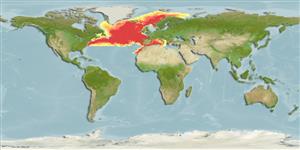Classification / Names
Common names from other countries
Main reference
Size / Weight / Age
Max length : 50.0 cm TL male/unsexed; (Ref. 1371); common length : 22.0 cm TL male/unsexed; (Ref. 1371); max. published weight: 830.00 g (Ref. 40637); max. reported age: 20 years (Ref. 1371)
Length at first maturity
Lm 15.0 range ? - ? cm
Environment
Marine; bathypelagic; oceanodromous (Ref. 51243); depth range 150 - 3000 m (Ref. 3663), usually 300 - 400 m
Climate / Range
Temperate, preferred 14°C (Ref. 107945); 79°N - 26°N, 82°W - 51°E (Ref. 1371)
Distribution
Northeast Atlantic: Barents Sea south through the eastern Norwegian Sea, around Iceland, then in the western Mediterranean, and south along the African coast to Cape Bojador. Northwest Atlantic: southern Greenland and off southeast Canada and the northeastern coast of the USA.
Countries | FAO areas | Ecosystems | Occurrences | Introductions
Short description
Dorsal
spines
(total): 0;
Dorsal
soft rays
(total): 24-28;
Anal
soft rays: 33 - 39. Dorsal fins widely spaced, interspace between second and third fins longer than base length of first dorsal fin. Lateral line continuous over whole body. Color is blue-gray dorsally, grading to white ventrally. Sometimes with a small black blotch at the base of the pectoral fin.
IUCN Red List Status (Ref. 115185)
Threat to humans
Harmless
Human uses
Fisheries: highly commercial
Tools
Special reports
Download XML
Internet sources
Estimates of some properties based on models
Phylogenetic diversity index
PD50 = 0.7500 many relatives (e.g. carps) 0.5 - 2.0 few relatives (e.g. lungfishes)
Trophic Level
4.1 ±0.3 se; Based on diet studies.
Resilience
Medium, minimum population doubling time 1.4 - 4.4 years (K=0.18-0.22; tm=1-5; tmax=20; Fec=6000)
Vulnerability
Low to moderate vulnerability (33 of 100)
Price category
